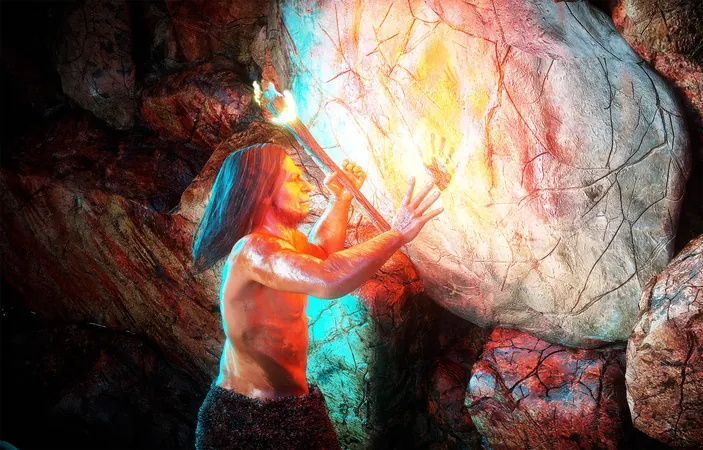
Did Early Humans and Neanderthals Recognize Their Differences? Unveiling the Mystery of Facial Evolution
2025-04-06
Author: Ling
Modern humans and Neanderthals showcase striking facial differences, a fact that raises intriguing questions about our evolutionary journey. While both groups share a common ancestor, the facial structure of modern humans is notably slimmer compared to the more robust features seen in Neanderthals and other hominins from our distant heritage.
Anthropologists are keen to understand the reasons behind these variations and the developmental changes in facial bone structure that contributed to this distinction. Recent research has put a spotlight on the importance of facial bone growth and how it diverged over time between the two species.
A comprehensive study from the Max Planck Institute for Evolutionary Anthropology, led by researcher Alexandra Schuh, investigated the growth patterns of facial bones in modern humans, Neanderthals, and even chimpanzees, our closest living relatives. By analyzing these different groups, scientists were able to pinpoint which specific growth trends set modern humans apart from their Neanderthal counterparts.
Comparing Facial Structures: Key Findings
One of the main conclusions from this research is that modern human faces stop growing earlier than those of Neanderthals and other large-faced primates. This shorter growth timeline results in a smaller facial structure, effectively distinguishing us from our heftier hominin relatives. Neanderthals, with longer growth periods, developed strong jaws and wider midfaces.
This crucial insight aligns with theories suggesting that the evolutionary pressures faced by our ancestors may have led to these physiological differences, helping humans adapt to their environments while conserving energy. As Schuh notes, “Changes in development—particularly during late growth stages—resulted in smaller faces, which indicate a shift that could be linked to our energy efficiency in daily functions like chewing.”
The Mechanisms Behind Facial Evolution
The underlying processes managing bone growth are also key to understanding these differences. In modern humans, the growth of the upper jaw—the maxilla—completes earlier, leading to a more compact face. In contrast, Neanderthal facial structures are characterized by prolonged growth, contributing to their robust features.
While certain facial characteristics may emerge early in life, major distinctions manifest during the final growth stages before adulthood. Research indicates that humans enjoy a relatively extended childhood, but our facial growth does not prolong for this duration, possibly reflecting adaptive changes in response to environmental conditions.
A Blend of Influences: Nature Meets Nurture
The reasons behind these evolutions are complex, intertwining both genetic and environmental factors. Some researchers suggest that advances in food processing and the development of cooking techniques may have lessened the strain on our jaws, contributing to smaller face structures. Meanwhile, social behaviors and selective pressures may have further shaped facial development through interactions within communities.
Future studies aim to explore fossil evidence from various time periods, uncovering whether different ancient human populations exhibited similar facial growth patterns. By investigating geographical contrasts, scientists hope to reveal how varying environments may have influenced the facial characteristics of early humans compared to Neanderthals.
Connections to Social Evolution
Importantly, the advantages of a smaller face extend beyond mere aesthetics. Enhanced facial communication and expression could play a vital role in interpersonal interactions within communities. Understanding the nuances of these traits through an evolutionary lens can shed light on the ways early humans may have navigated their social worlds.
In conclusion, the research illuminates how the timing and pace of facial bone growth have significant implications for our understanding of human evolution. Recognizing these subtle yet powerful changes not only enhances our comprehension of how we differ from our ancient relatives but also emphasizes the intricate relationship between biological evolution and social behavior.
This groundbreaking study, published in the Journal of Human Evolution, paves the way for future investigations into our evolutionary lineage, revealing the profound complexities of our past beyond just physical attributes. What else might we learn about our unique journey? As scientists continue to unravel these mysteries, the story of human evolution remains an exciting frontier.


 Brasil (PT)
Brasil (PT)
 Canada (EN)
Canada (EN)
 Chile (ES)
Chile (ES)
 Česko (CS)
Česko (CS)
 대한민국 (KO)
대한민국 (KO)
 España (ES)
España (ES)
 France (FR)
France (FR)
 Hong Kong (EN)
Hong Kong (EN)
 Italia (IT)
Italia (IT)
 日本 (JA)
日本 (JA)
 Magyarország (HU)
Magyarország (HU)
 Norge (NO)
Norge (NO)
 Polska (PL)
Polska (PL)
 Schweiz (DE)
Schweiz (DE)
 Singapore (EN)
Singapore (EN)
 Sverige (SV)
Sverige (SV)
 Suomi (FI)
Suomi (FI)
 Türkiye (TR)
Türkiye (TR)
 الإمارات العربية المتحدة (AR)
الإمارات العربية المتحدة (AR)